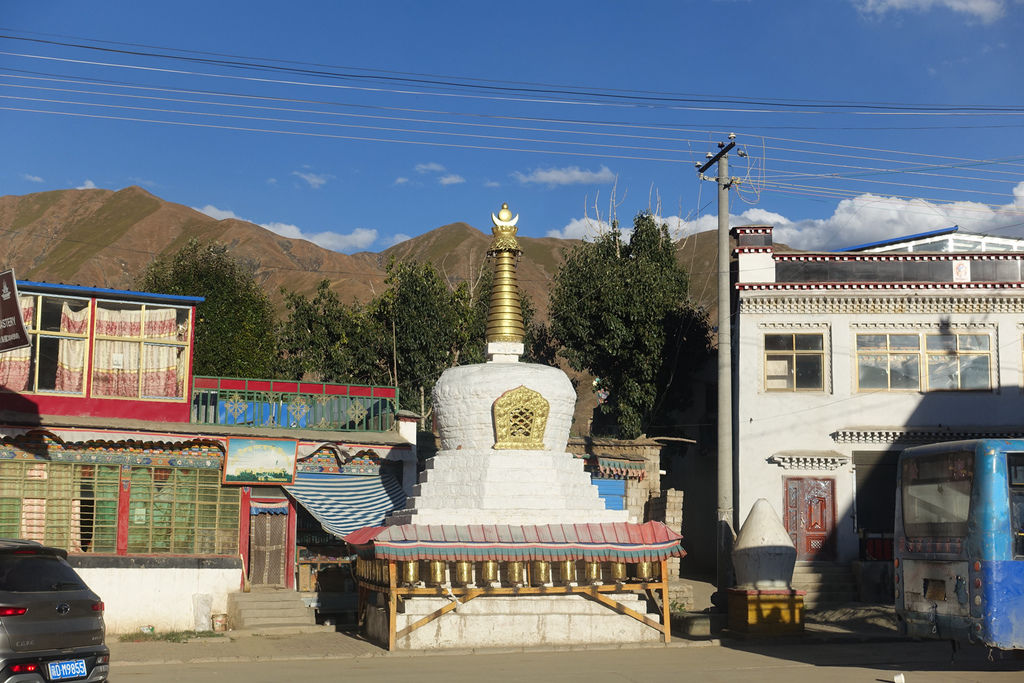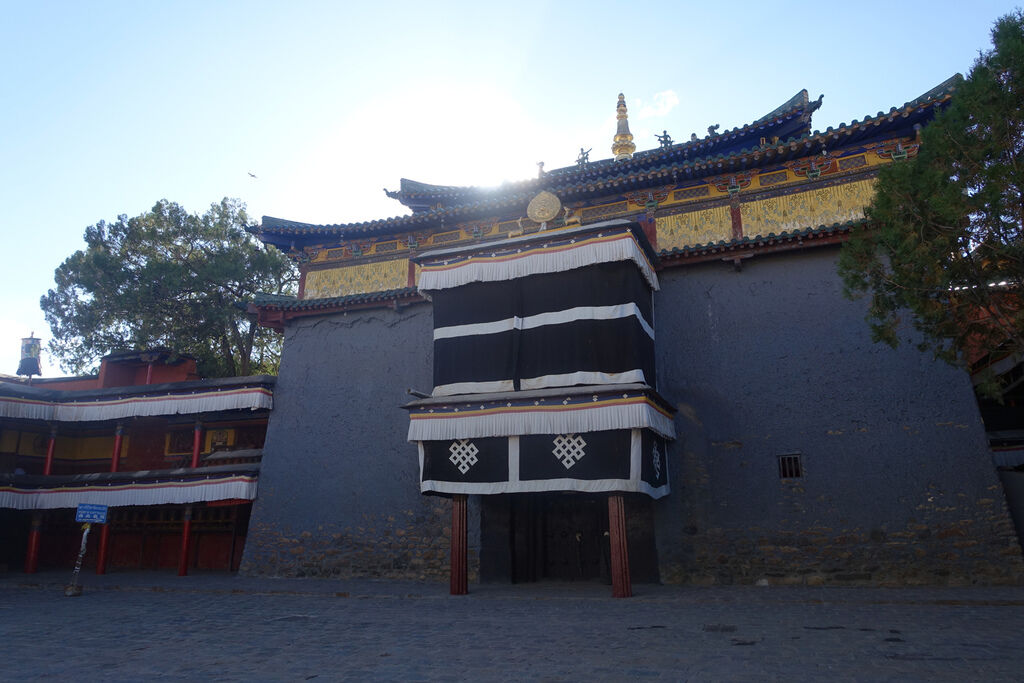
Xialu Temple is located in Jiacuoxiong Township, Shigatse City. According to temple history, Xialu Temple was first built in 1087 AD. The founder of the temple was Jie Zunjia Rao Qiongni. In 1320 AD, Xialu Temple invited Master Buton to preside over the temple. He established the Shalu Sect in Tibetan Buddhism. In 1333 AD, Master Buton rebuilt the temple. It is the ancestral temple of Xialu Sect of Tibetan Buddhism.
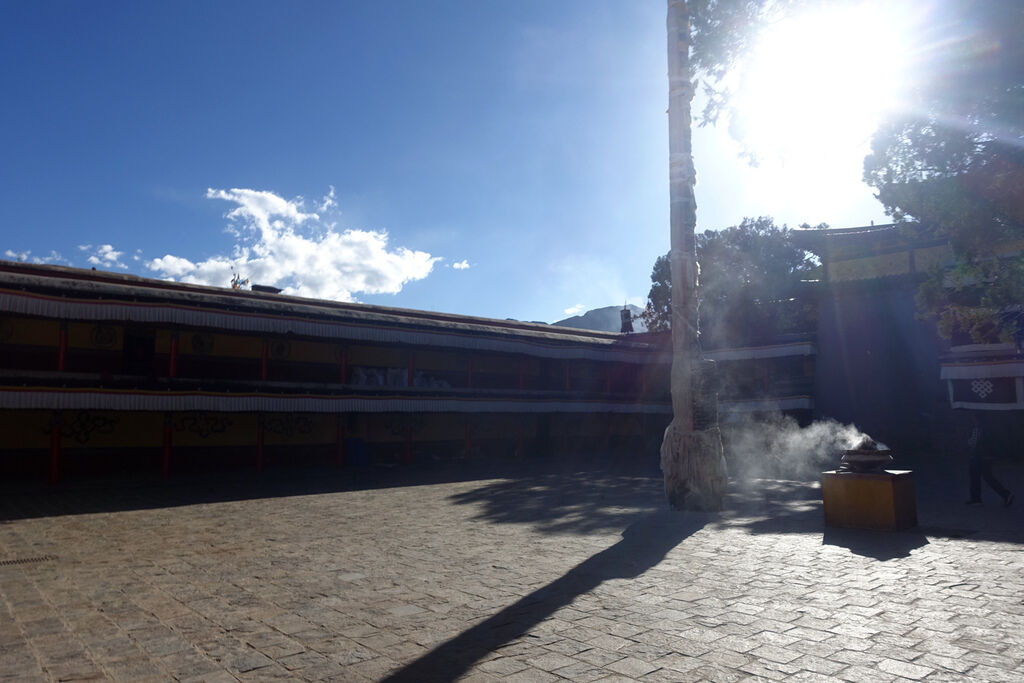
Xialu Monastery is on the way from Lhasa to Shigatse, between Baiju Monastery and Shigatse. Basically, no tourist groups come here. However, I like Tibetan Buddhist cultural relics, so I came to Xialu Monastery to look for it.
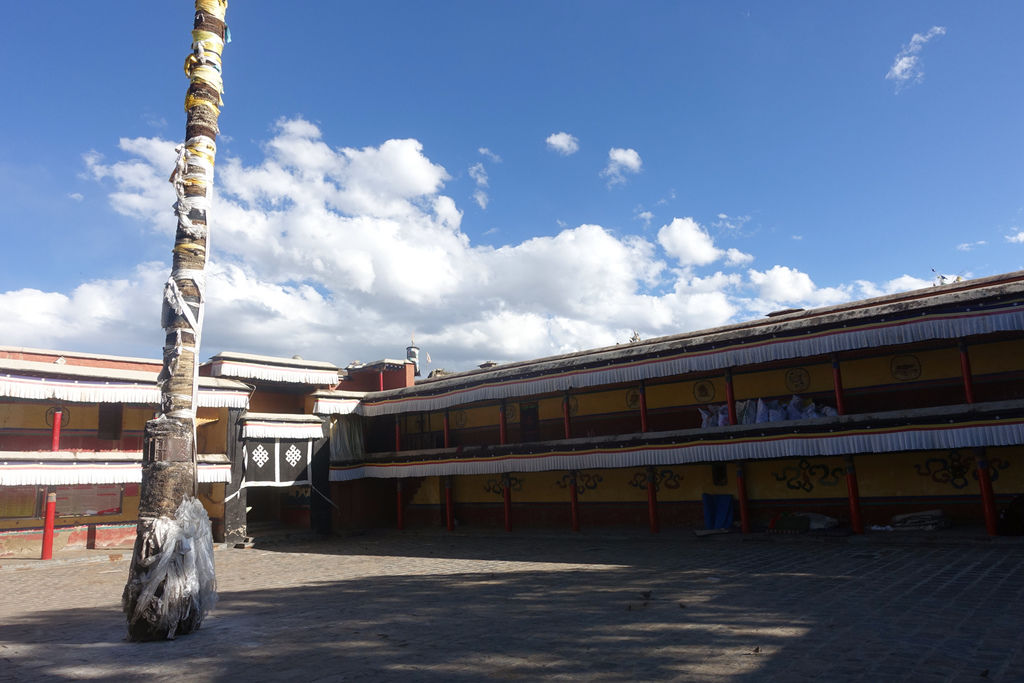
Xialu Temple is most famous for its well-preserved murals. We were attracted by these arts. I arrived at Xialu Temple at about 4:30, and the temple was sparsely populated. The temple was about to close, so we rushed to visit in the last minute.
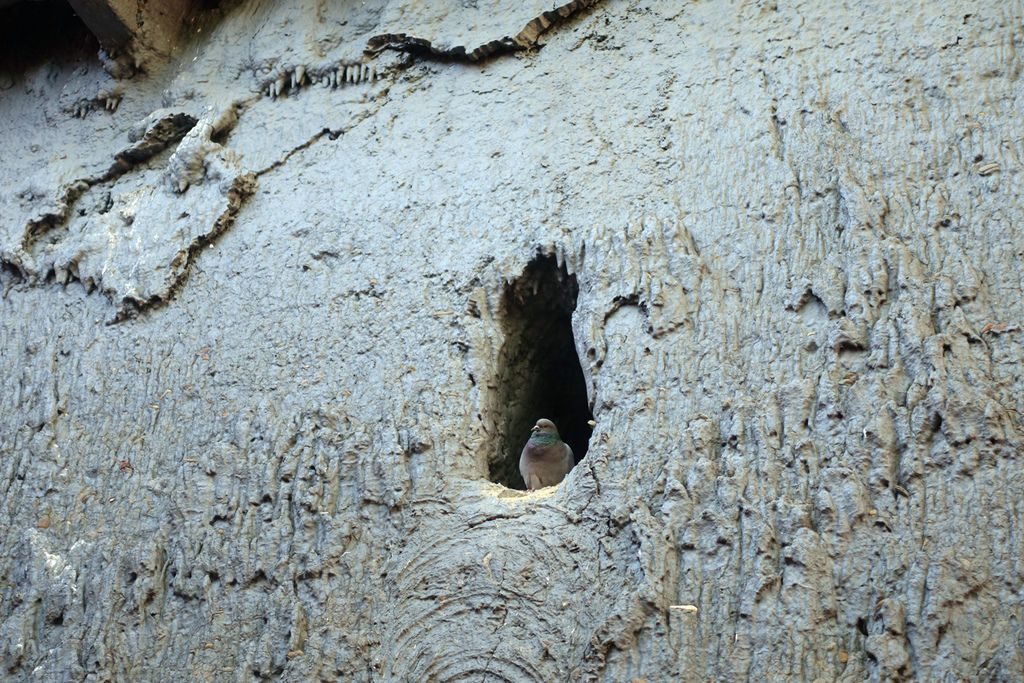
There is also a pigeon hole on the wall of Xialu Temple!! It is very protective of animals!!
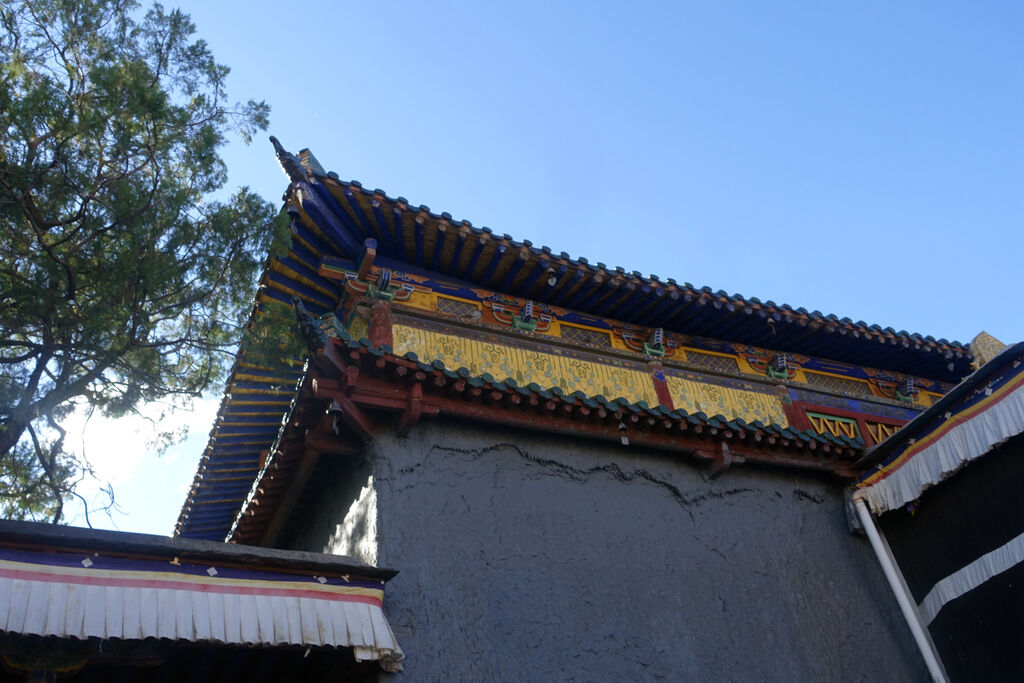
The main building of Xialu Temple is Xialu Hall, also known as “Xialu Lakang”. Its architecture is very special, with high ridged brackets on the roof, glazed tile troughs, and flying eaves, like wings. There are stacked wood carvings under the eaves, and there are no iron connections. The shape and structure are all imitated in the style of temples built in the mainland. The eye-catching red walls, built with blank stones, and closely connected halls also reflect the characteristics of Tibetan temple construction. The architecture of the temple is the crystallization of a combination of Tibetan and Han national architectural art. (Internet information)
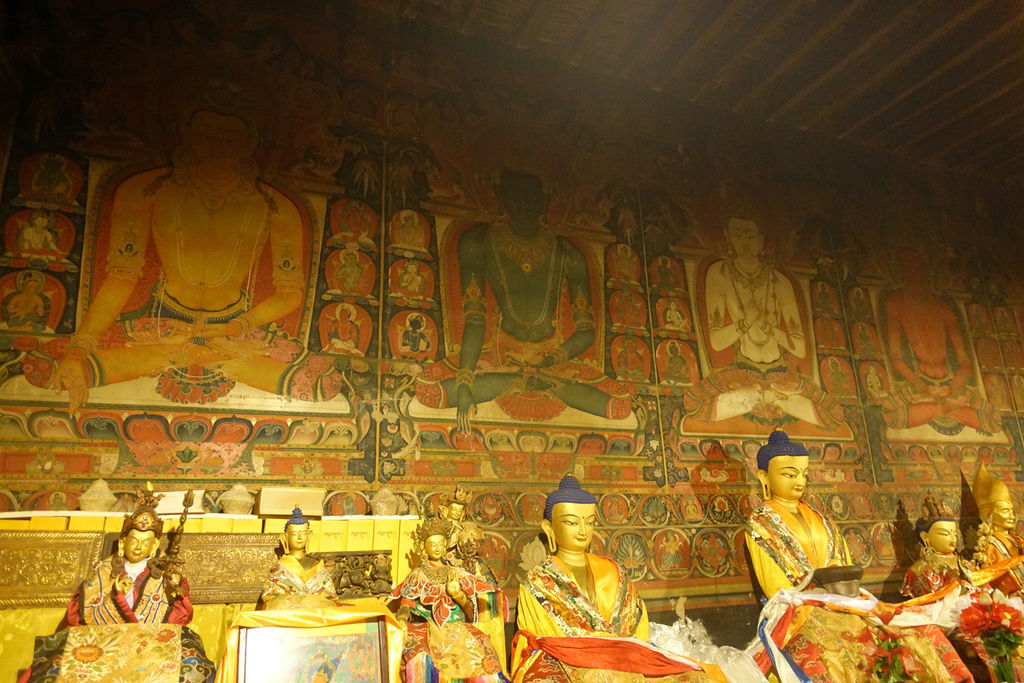
After we entered Xialu Temple, I asked the monks of Xialu Temple for permission, and the monks agreed to take photos throughout the process . The following photos are of the original murals and treasures of Xialu Temple. If you are unable to go to Tibet to appreciate them in person, you can view them in this article Enjoy the splendor of Shalu Temple
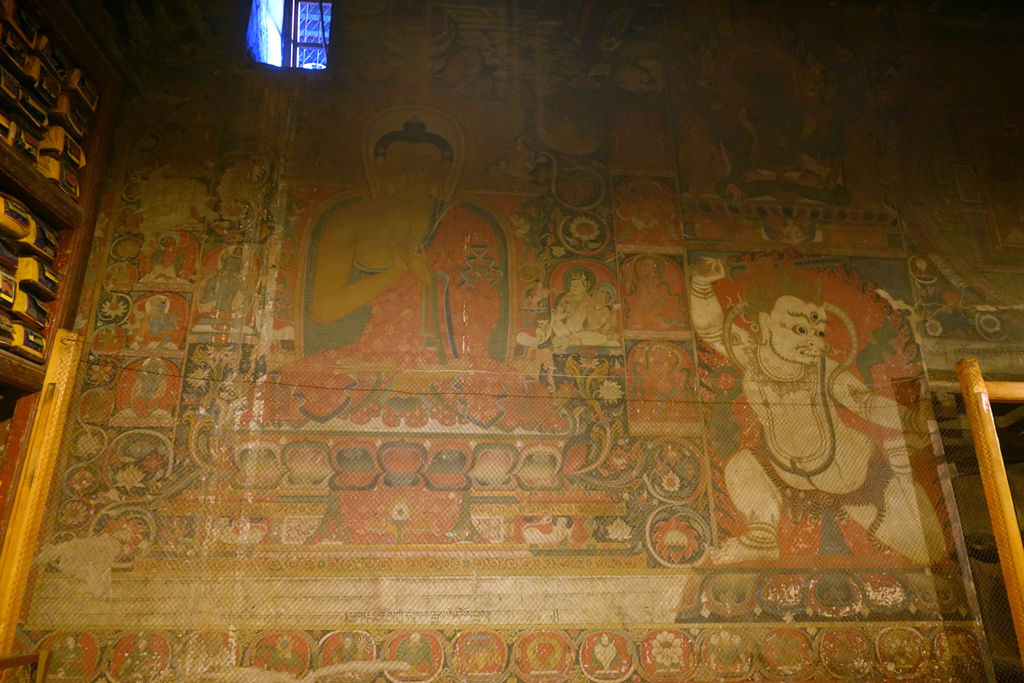
Xialu Temple houses a large number of murals, Buddha statues, scriptures, thangkas, ritual instruments and other historical relics, among which the four major temple treasures are famous:
The first treasure is the “L-shaped sutra board”: during the construction of the temple, 108 small wooden boards were used to form a square shape, and each board was engraved with a sutra text. A scripture is composed of 108 tablets. When religious believers go to worship, they all hope to get a scripture that “dispels disasters and brings blessings” printed on a spelling board.
The second treasure is the “Holy Water Altar”: a large bronze altar with a diameter of 80 cm is displayed in the southeast corner of the Sutra Hall. Legend has it that the water in this altar is changed once every twelve years. When the water is changed, the original clean water does not increase or decrease. People who can get the “holy water” in this altar will have good luck in their lives and can also wash away 10 kinds of dirt.
The third treasure is the “Six-Character Mantra Stone”: Legend has it that this stone was unearthed when digging the foundation for the temple. When it was excavated, there were six-character mantras written on the stone, and there were four small pagodas at the four corners, so it was said that it was a natural stone. Six-character mantra stone. It is placed at the foot of the temple wall and serves as the cornerstone of the temple.
The fourth treasure is the “stone washbasin”: it is said that it was the washbasin of Jizun Xiraoqiongnai, the founder of the temple, who practiced asceticism at that time and placed it in front of the main hall. It is very magical that the rainwater does not overflow after it accumulates.
The above is online information
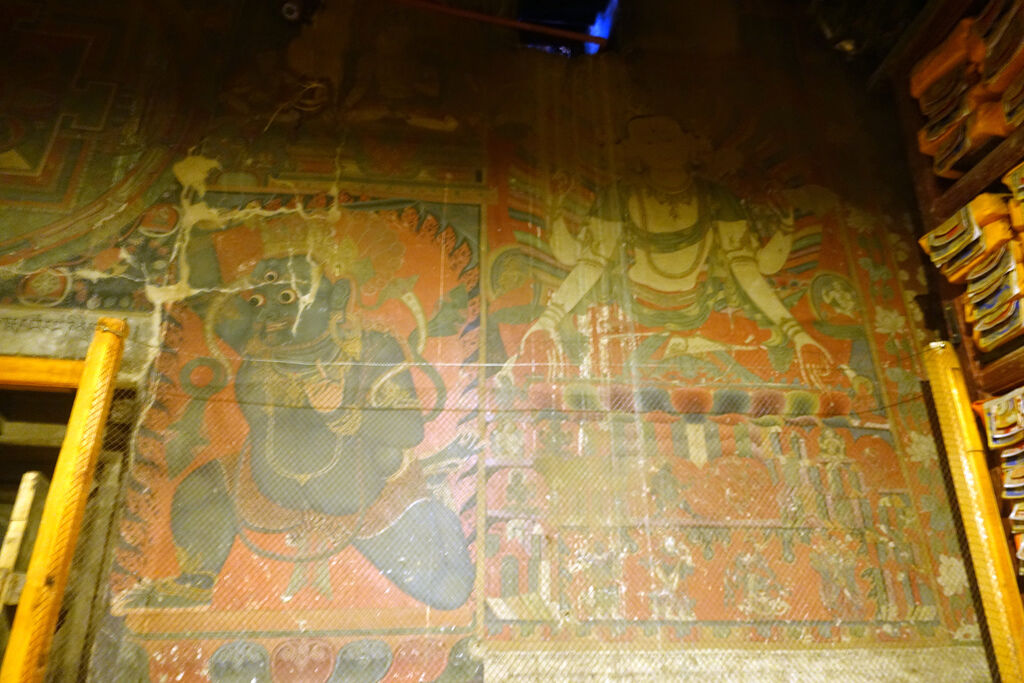
The murals in Xialu Temple are examples of Tibetan Buddhist mural art in the Yuan Dynasty. The subject matter consists of two sects, sutra and esoteric. Sutras mainly focus on Tibetan stories and Buddha’s Jataka stories, which are mainly concentrated around the corridor of the Golden Hall on the first floor. Among them, the murals of Buddha’s Jataka stories are the most exciting, with a total of 100 pavilions (96 existing pavilions). According to the Karma Kagyu Black Hat Collection The fourth life of the living telescope was drawn from the collection of Buddha’s Jataka stories (One Hundred Jatakas) written by Jong Duoji (1284-1339). It has a grand composition and adopts a chess pattern. It goes around the outer wall of the cloister and is magnificent. It is a unique mural in Xialu Temple. . The main Buddhist stories include “The Twelve Phases of Enlightenment” and “The Sumati Girl Invites the Buddha”. The composition is also very large. It is a representative work of similar themes among Tibetan Buddhist temple murals. (online information)
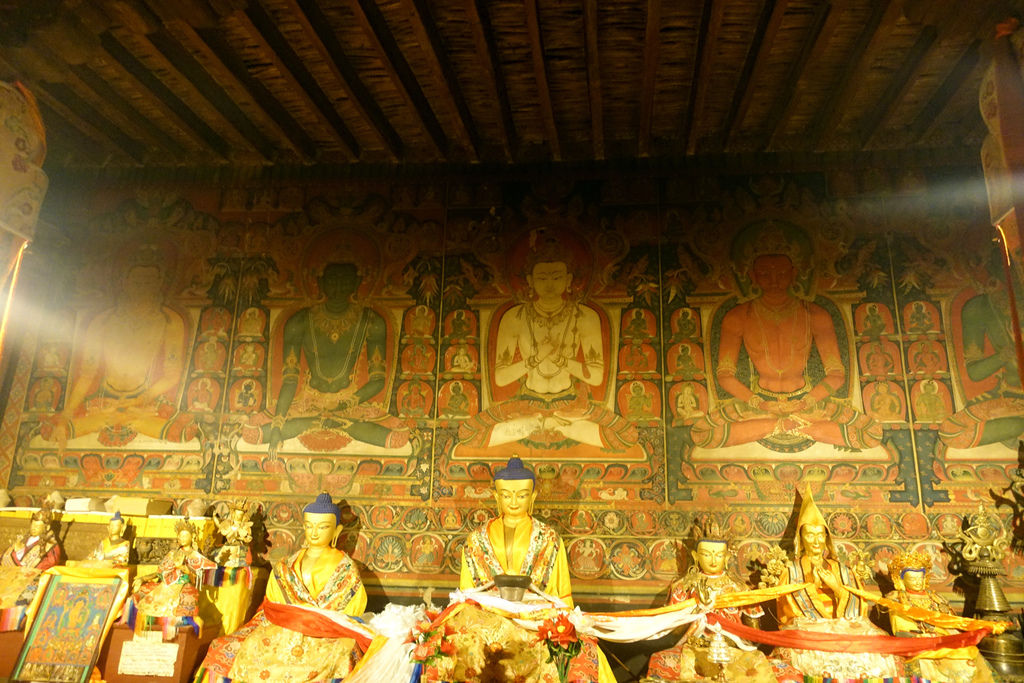
Tantric themes mainly include the mandala and the portraits of Buddhas, Bodhisattvas, and Mingwang Dharma protectors in the mandala, including the five Buddhas on the inner wall of the first-floor corridor (namely: Vairochana Buddha, Akho Buddha, Amitabha Buddha, Precious Buddha, and Amitabha Buddha). , a single portrait in the Prajna Mother Hall and a large mandala mural in the three-story East, West, South and North Wuliang Palace. It mainly depicts a series of mandala murals such as the Auspicious Victory Mandala, the Vajra Realm Mandala, the Universal Mandala Wing and the Manjusri City Mandala, all of which are painted according to the ritual of Master Butun’s 100,000 mandala statues. Among them, the Manjusri Mandala series of murals in the Wuliang Palace in the East were painted by Master Butun novice and are very precious. (online information)
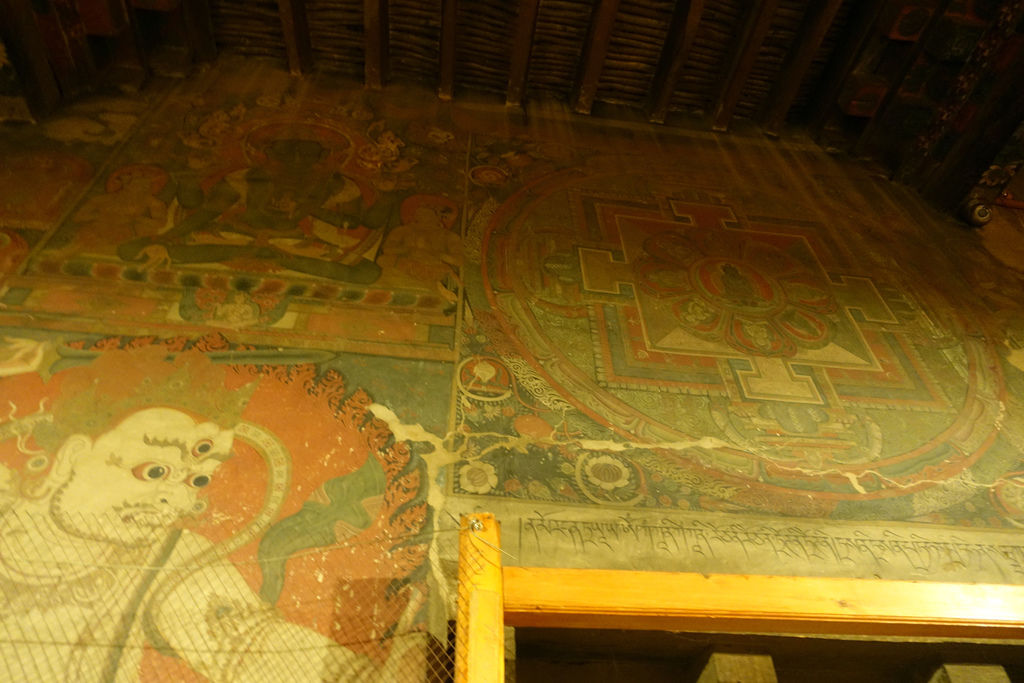
The murals in Xialu Temple are a model of Tibetan Buddhist murals in the Yuan Dynasty. The main themes are divided into Sutra and Tantra.
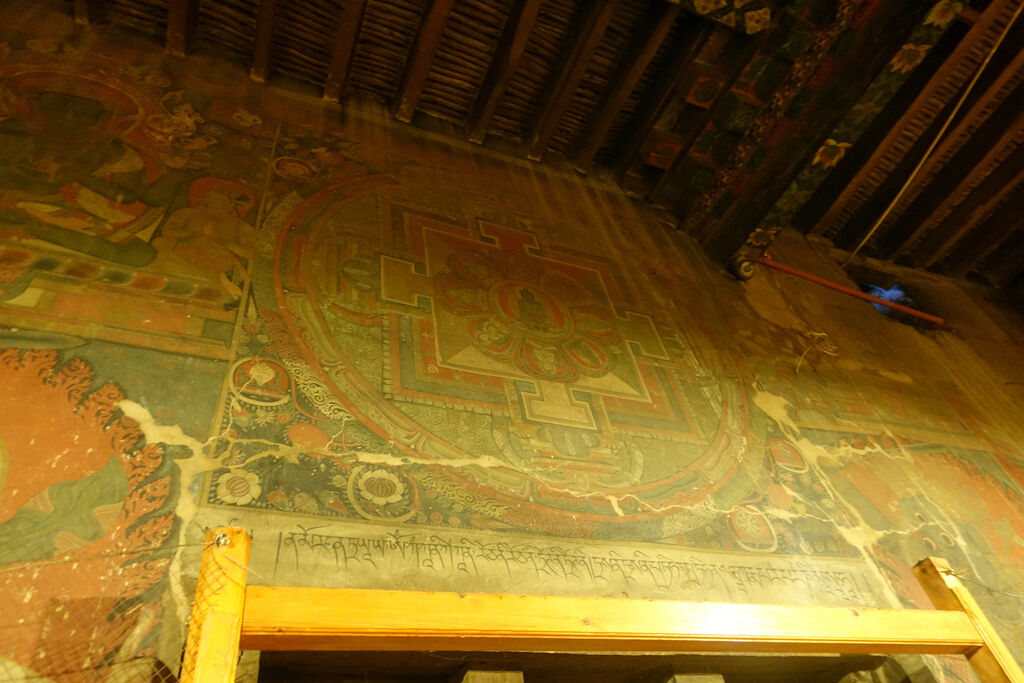
Sutra murals: mainly Buddhist stories and stories about the life of Buddha, distributed around the cloister of the Golden Hall on the first floor. Among them, there are a total of 100 murals of Buddha’s Jataka stories (96 are now available), based on the collection of Buddha’s Jataka stories (One Hundred Jatakas) written by Rangjong Dorje (1284-1339), the fourth living Buddha of the Karma Kagyu Black Hat line. It is drawn in a chess format and goes around the outer wall of the corridor. The Buddhist stories mainly include “Twelve Phases of Enlightenment” and “Nv Sumati’s Invitation to the Buddha”.
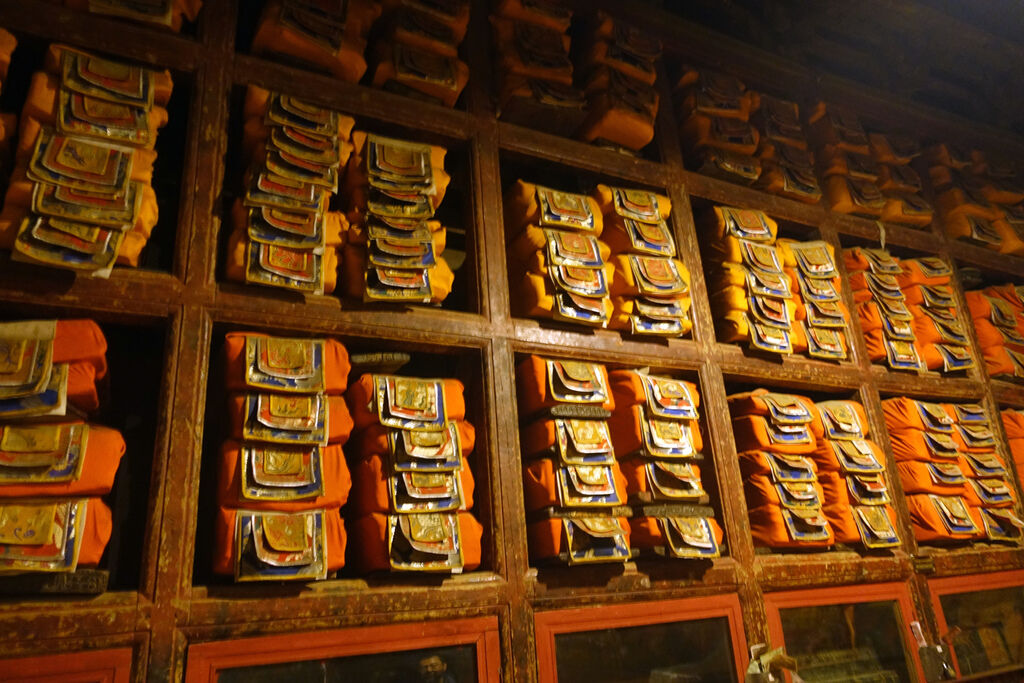
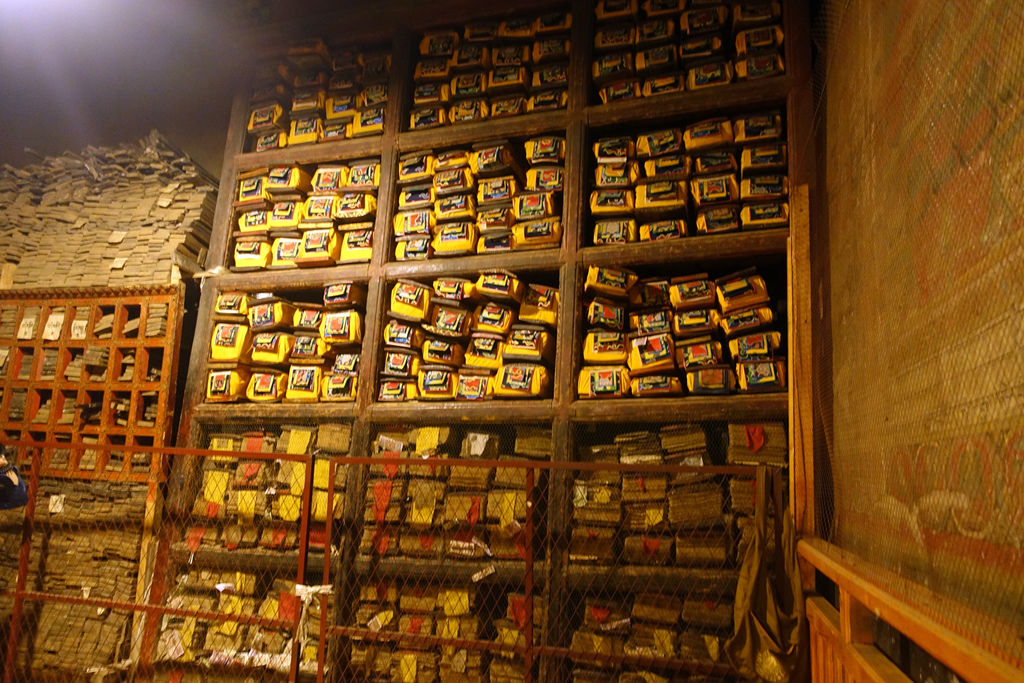
Scripture
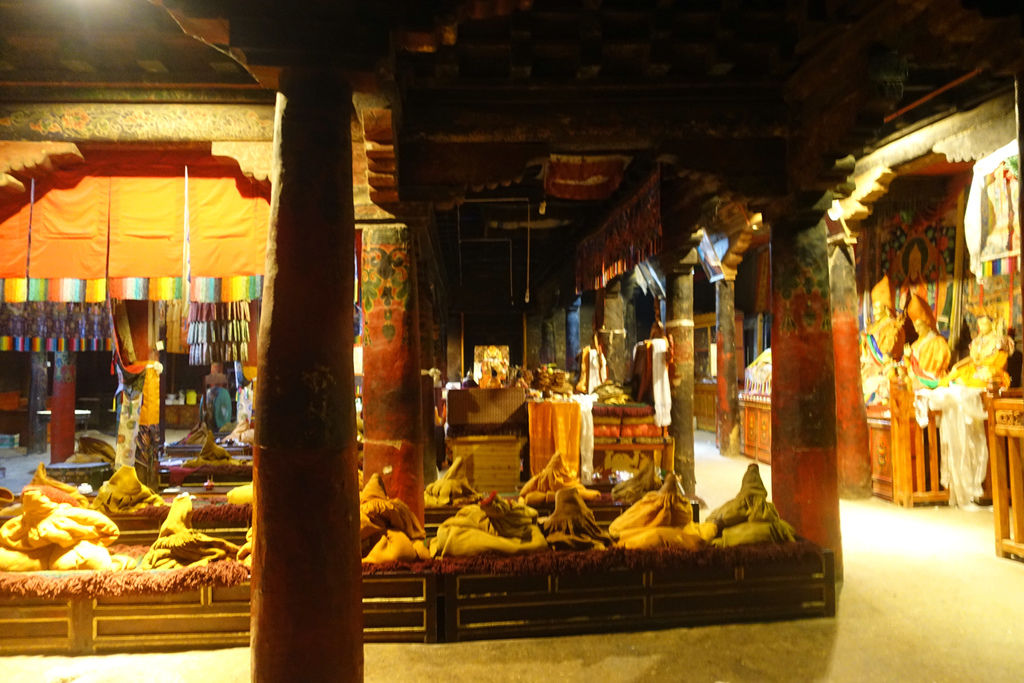
The Xialu Hall faces west and faces east, with two floors. The main hall on the ground floor is the assembly hall, covering an area of about 1,500 square meters. It houses statues of Sakyamuni and the eight disciples. There is a sutra hall on each side, enshrining “Ganyur” and “Kanjur”. “Tenjur” scripture. The second floor of the main hall is completely in the layout of a Chinese-style quadrangle, with a main hall, a side hall and a front hall, with clear axes and symmetry. The four halls are all equipped with glazed tops, cornices and arches, with simple styles and various patterns, including flying apsaras, ladies, ligers, tigers and flowers, which are lifelike. There are statues of Sakyamuni and Master Butun in the main hall, as well as various bronze Kadam pagodas of different sizes. (Internet information)
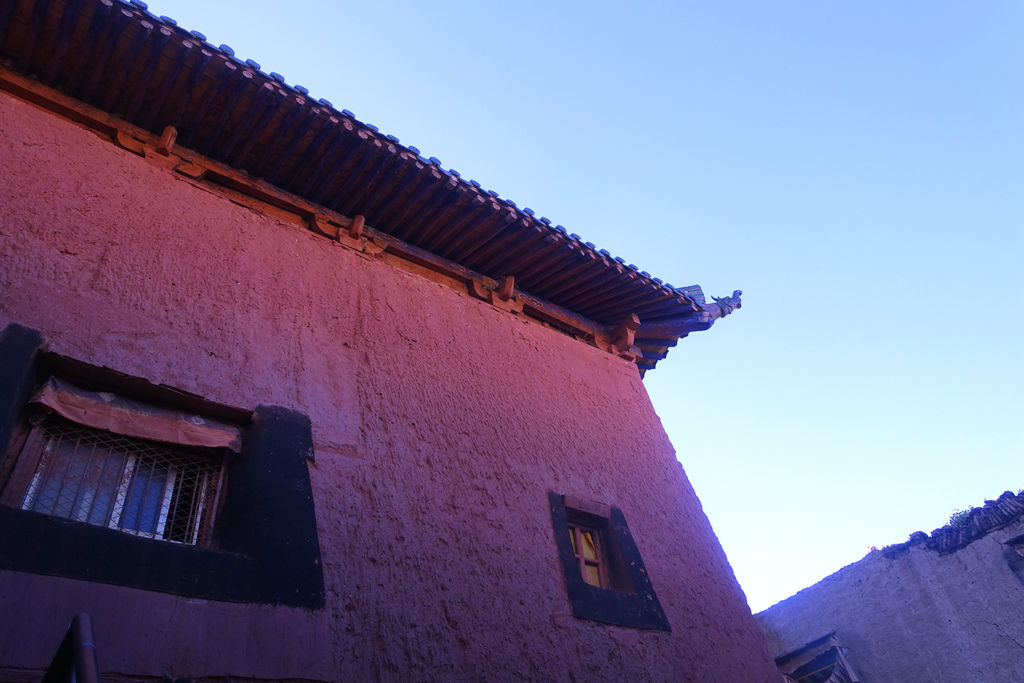
The temple was first built in 1087 (the second year of Yuanyou in the Northern Song Dynasty) and was presided over by Jizun Xiraoqiongnai of the Sakya Sect. The Jizun family was originally descended from the royal family of the Xiangxiong area. During the Tubo period, many members of the Jizun family were highly employed by Zanpu. In 998, the post-promulgation period of Tibetan Buddhism began. At that time, Buddhists Rumei Chuchenxirao and other ten people from Tibet (Rumei Chuchenxirao, Zhang Yixiyundan, Rexi Chuchenjunle, Ba ·Chu Chen Luo Zhe, Sumpa Yeshi Luo Zhe and other five people from the front Tibet; Lodun Dorje Wangxiu, village leader Sherab Sengge, Potongpa Degar and other back Tibetan people; Ali Ojie After the annihilation of Buddhism in Langdama, they heard that the great lama Qin Gongpa Raosai (about 891-975) who had fled to Qinghai from Tibet was an eminent monk, so he went to worship him as his teacher. Finally, one of the ten people, Lodun Dorje Wangxiu, returned to Tibet after completing his studies. He built a temple named “Jiankong” in Jiacuo, southeast of Shigatse, and accepted a disciple “Jizun Siraoqiong”. So”. Ji Zun Siraoqiong later came to India to study and became a Buddhist scholar. In order to develop Buddhism, Ji Zun Sirai Qiongnai hoped to build a temple, so he asked Lodun Dorje Wangchuk to shoot an arrow to locate the temple site. The arrow landed in the field of green seedlings that had just grown crops. “Green seedlings” are called “green seedlings” in Tibetan. Xialu”, so the temple was named “Xialu Temple”. (online information)
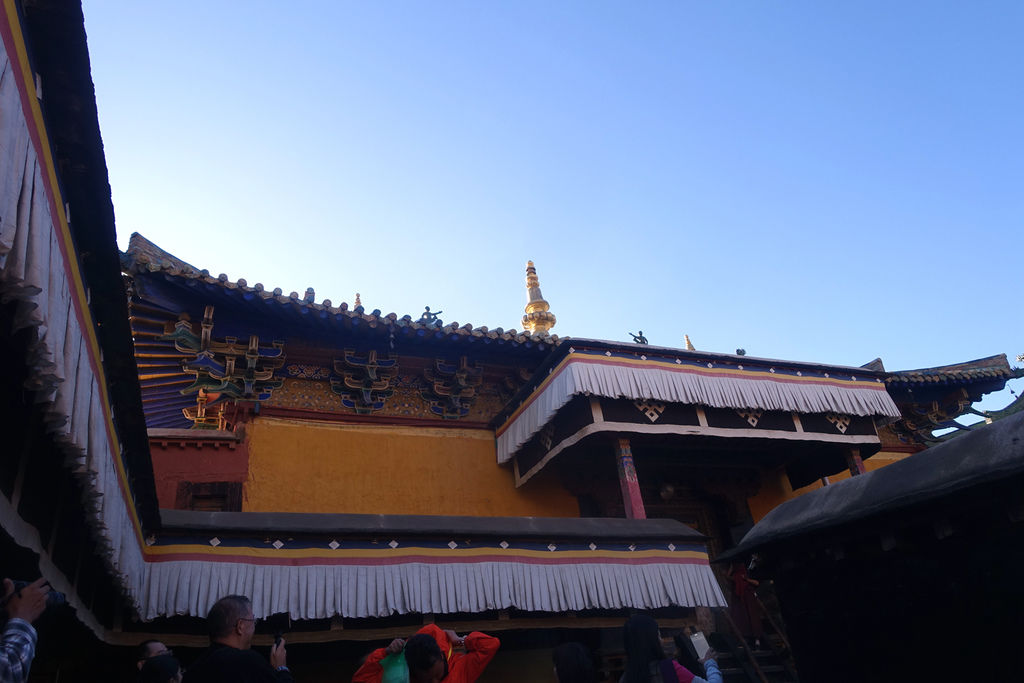
According to Tibetan religious history books, in 1320, the head of the Xiaruwan household, Drakpa Gyaltsen (belonging to the Jizun family), married his sister Xunubey to Sakya for marriage. Later, the power of the Jizun family gradually expanded. Later, Drakpa Gyaltsen went to mainland China to pay a pilgrimage to the emperor of the Yuan Dynasty, and was granted a gold book and gold seal by Yuan Renzong. Yuan Renzong also donated money and sent craftsmen to help expand Xialu Temple in accordance with Drakpa Gyaltsen’s request. The current architectural scale, architectural style and most of the paintings and sculptures of Shalu Temple were created during this expansion. After the expansion of the temple was completed, Drakpa Gyaltsen, the head of the Xialu family, invited the eminent monk Butun Rinchendup to serve as the head of the temple. (online information)
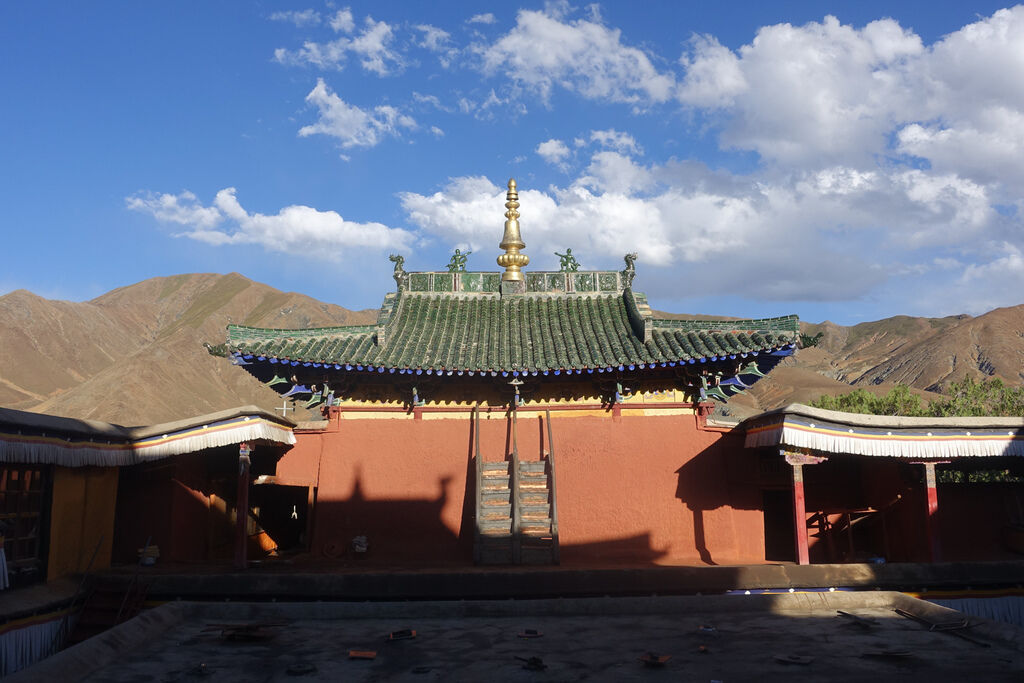
On the top of the main hall of Xialu Temple, it is three stories high, about 8 meters long and 5 meters wide. The glazed tiles, porcelain carvings, and square tiles used in the paving can be easily recognized as products from the Mainland. If the side halls are made with imitation tiles cast from the Mainland, traces of imitation can be seen at a glance. In the main hall, the ancient murals have been restored. The murals are rich in content, exquisite in workmanship, vivid in story, and strongly rendered, quite in the style of Yuan Dynasty murals. To give just one example, the Bodhisattva portraits in Shalu Temple are different from other temples. In terms of artistic style, it has absorbed more mainland styles, which appear simple and vivid, and also mixed with Nepalese and Indian styles, which appear lively and graceful; more are post-Tibetan paintings, which appear elegant and solemn. (online information)
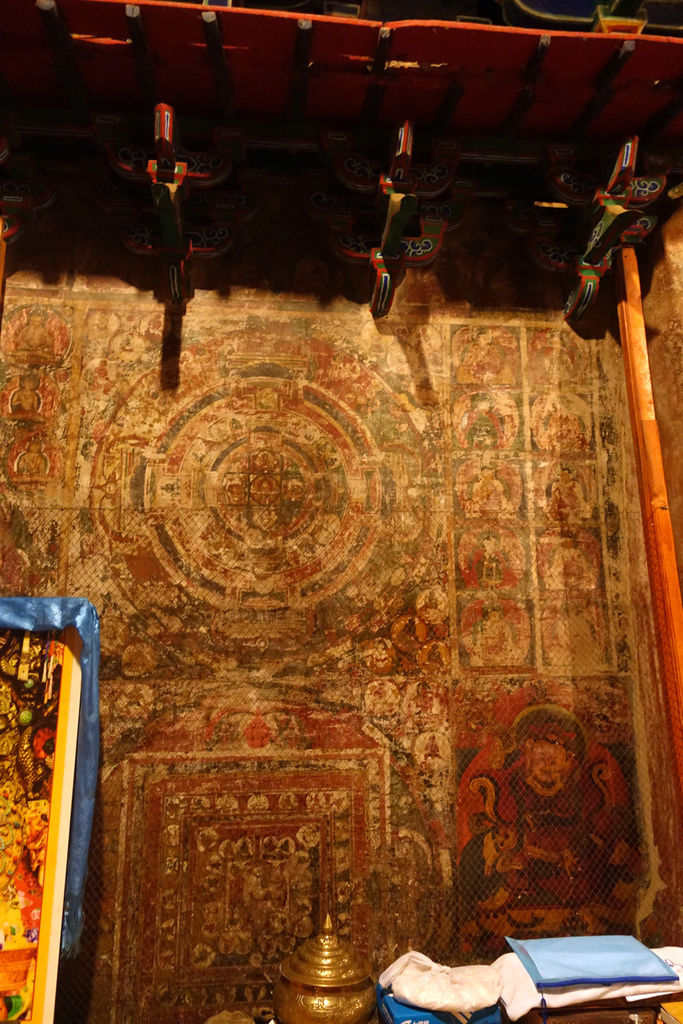
The murals of Xialu Temple had a significant impact on the mural art of Tibet in the late Yuan and early Ming dynasties. To the north, it influenced the mural art of temples such as Juenang Temple, promoting the emergence and formation of the Ladui artistic style; to the southeast, it influenced the formation of the mural art of the famous Baiju Temple in Gyantse in the Ming Dynasty. Therefore, the murals in Xialu Temple play a connecting role in the Tibetan mural art of the Yuan and Ming dynasties, and are a milestone in the development history of Tibetan art in the Yuan and Ming dynasties. The exchanges between Tibetan art in the Yuan and Ming dynasties and the Central Plains, Nepal, India and other places have important reference value. (online information)
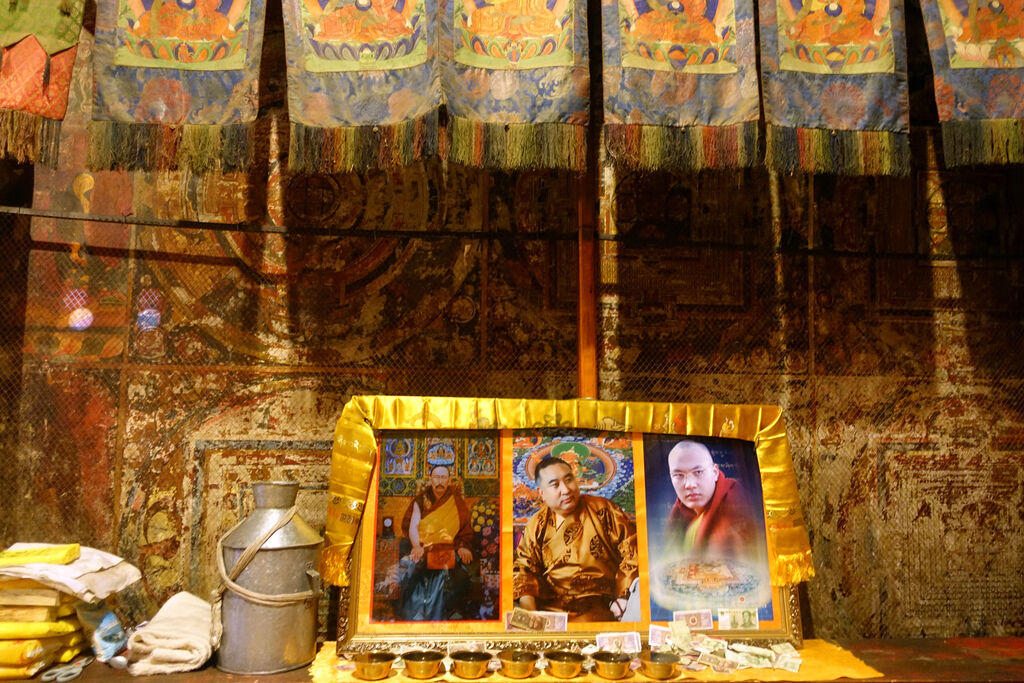
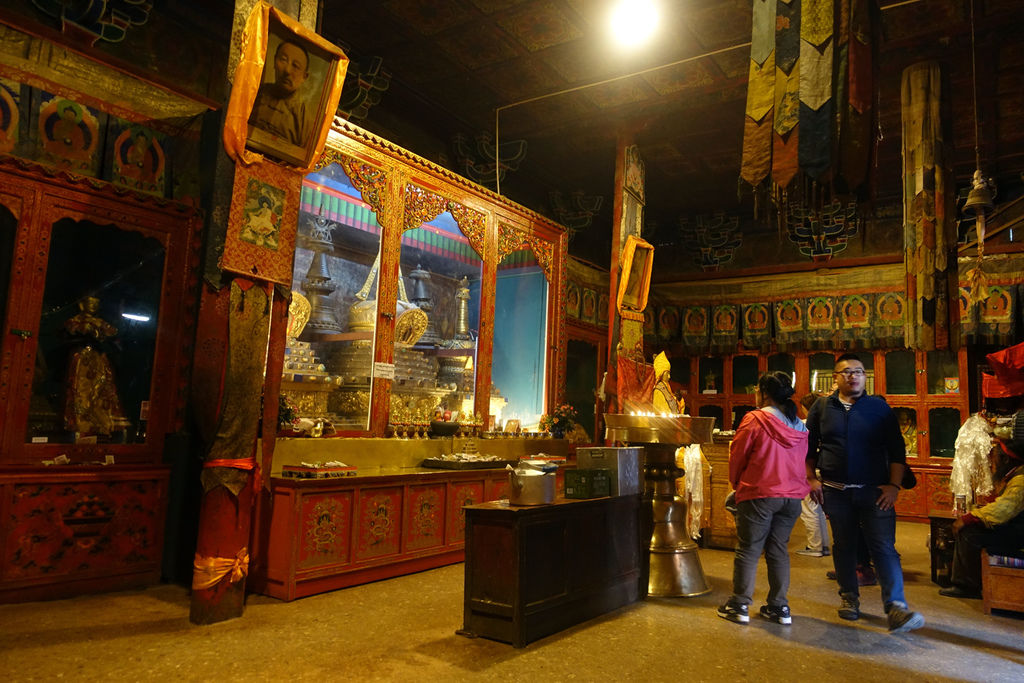
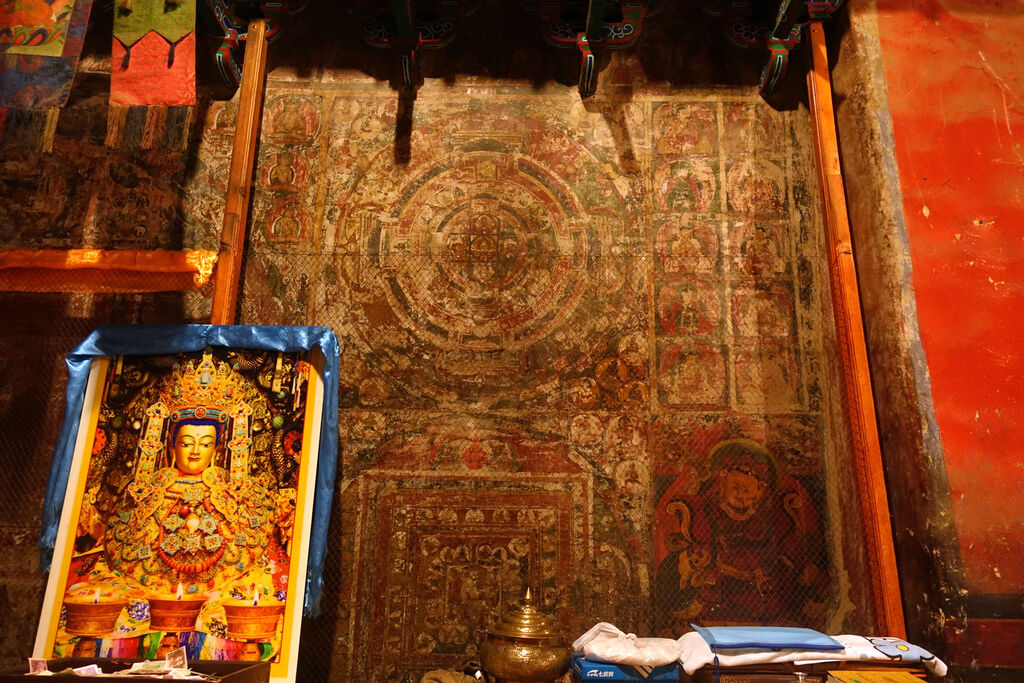
Although the overall area of the main hall is not very large, the exquisite statues, rich murals and exquisite plastic arts in the hall are extremely rare. In the left-turn corridor at the back of the sutra hall of the main hall, the upper part of the wall is covered with murals. The inner walls of the corridor are painted with thousands of Buddhas; the outer walls are mostly filled with stories of Buddhas, stories of listening to scriptures, etc. There are many images of life activities in the painting. The content of the mural is extremely rich, the form is vivid and lively, and the brushwork is exquisite and powerful. In the style of murals, many places have absorbed the artistic styles of Nepal or India, but there are also many scenes that are similar to the Song and Yuan Dynasty murals of the Dunhuang Grottoes, and the clothing, accessories, furniture and architecture of the characters in the paintings also have mainland styles. Murals of this style are relatively rare in ordinary temples in Tibet. (online information)
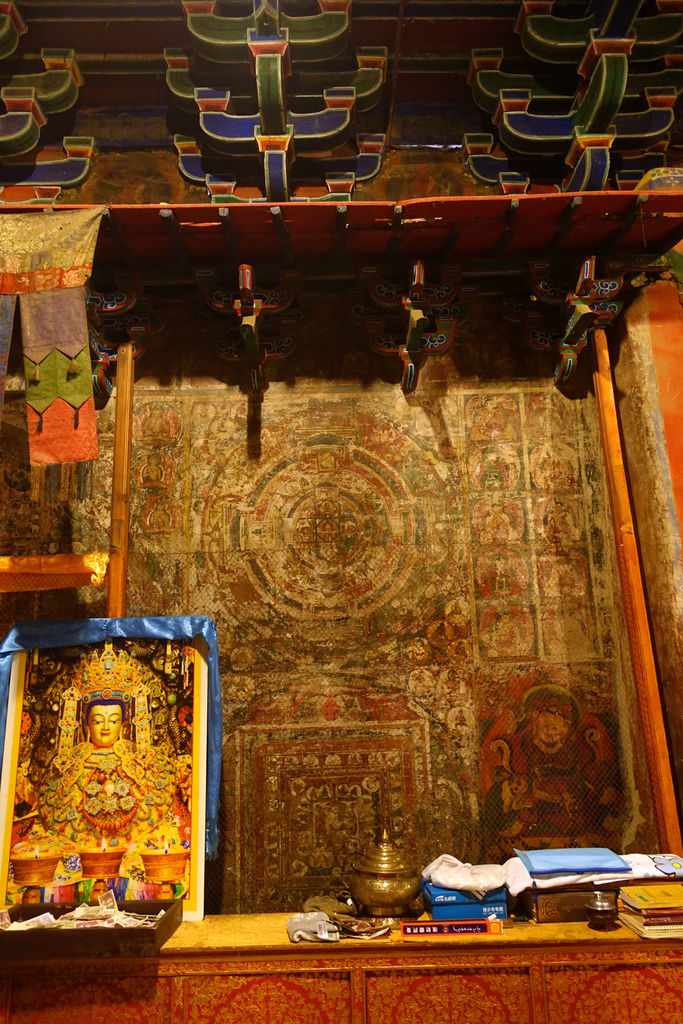
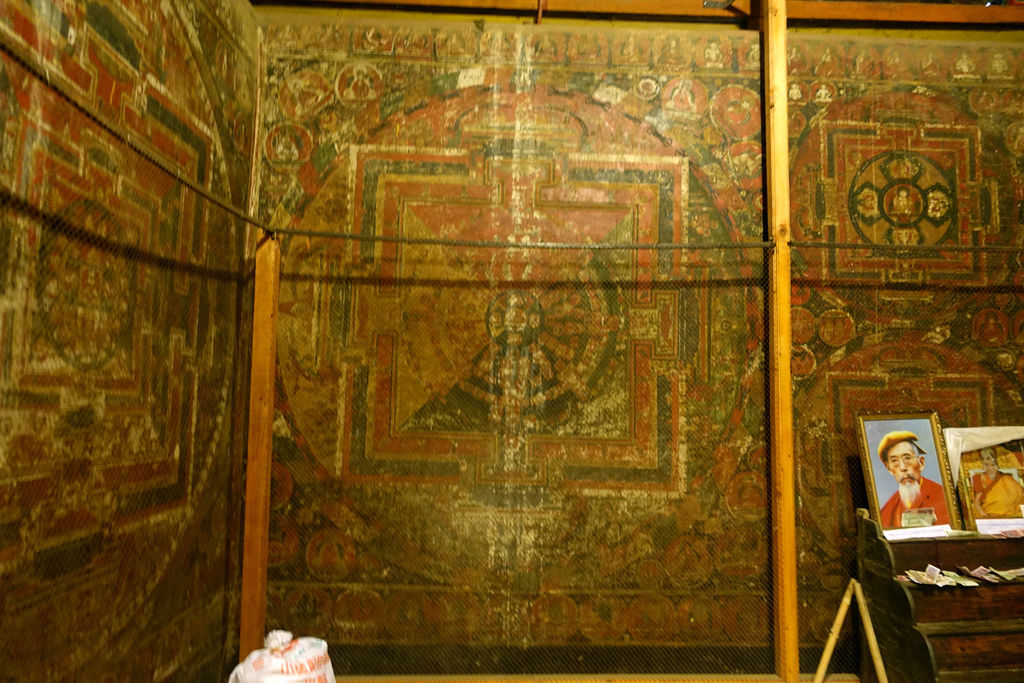
Tantric murals: mainly the mandala and the portraits of Buddhas, Bodhisattvas, and Mingwang protectors in the mandala. Among them are the five Buddhas (Vairocana Buddha, Akho Buddha, Amitabha Buddha, Baosheng Buddha, and Buddha Avatar) on the inner wall of the first-floor corridor, a single portrait of the Prajna Mother Hall, and the three-story East, West, South, and North Infinite Palace. Large mandala murals inside. The mandala murals mainly depict the auspicious victory mandala, Vajra Realm mandala, Puming mandala, Manjusri mandala, etc., all of which are drawn according to the ritual of Master Butun’s one hundred thousand mandala statues. Among them, the Manjusri Mandala series of murals in the Dongwuliang Palace were painted by Master Butun himself.
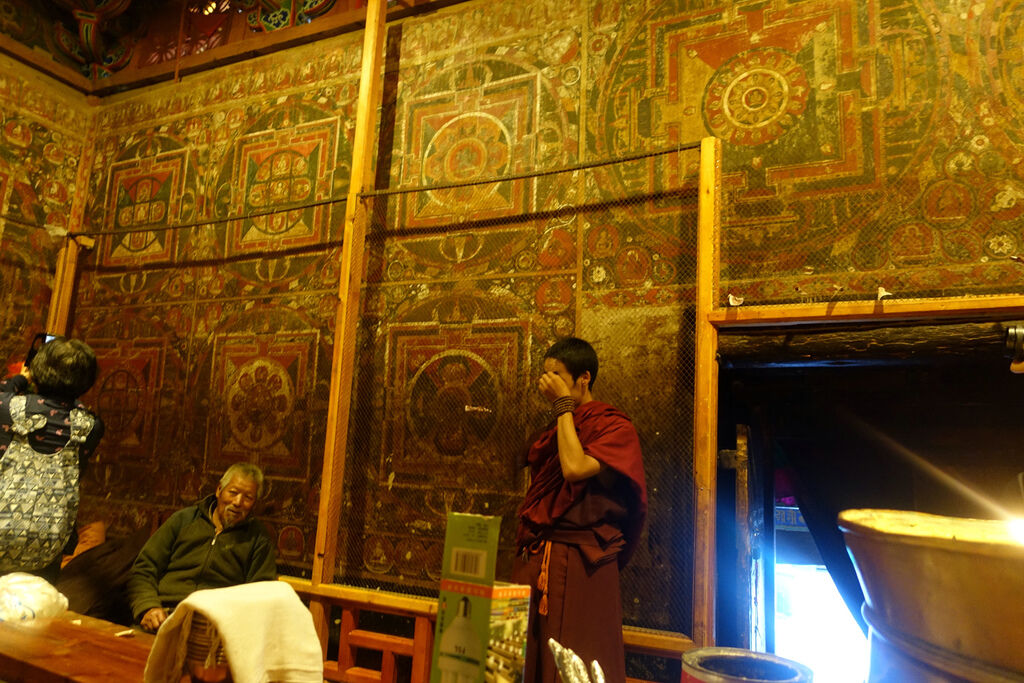
accompanying monks
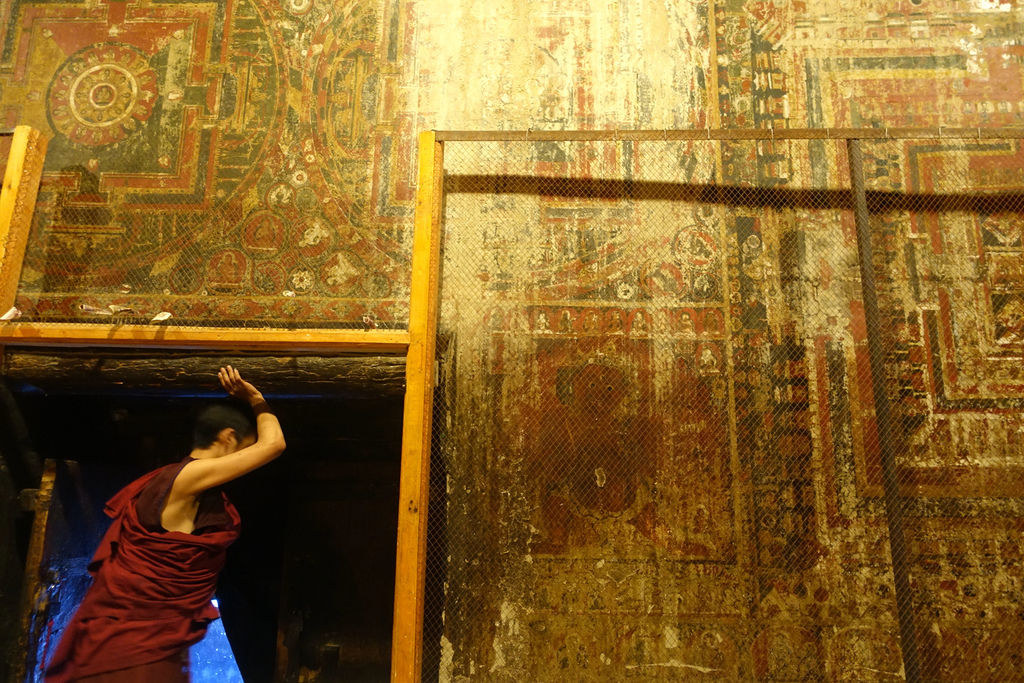
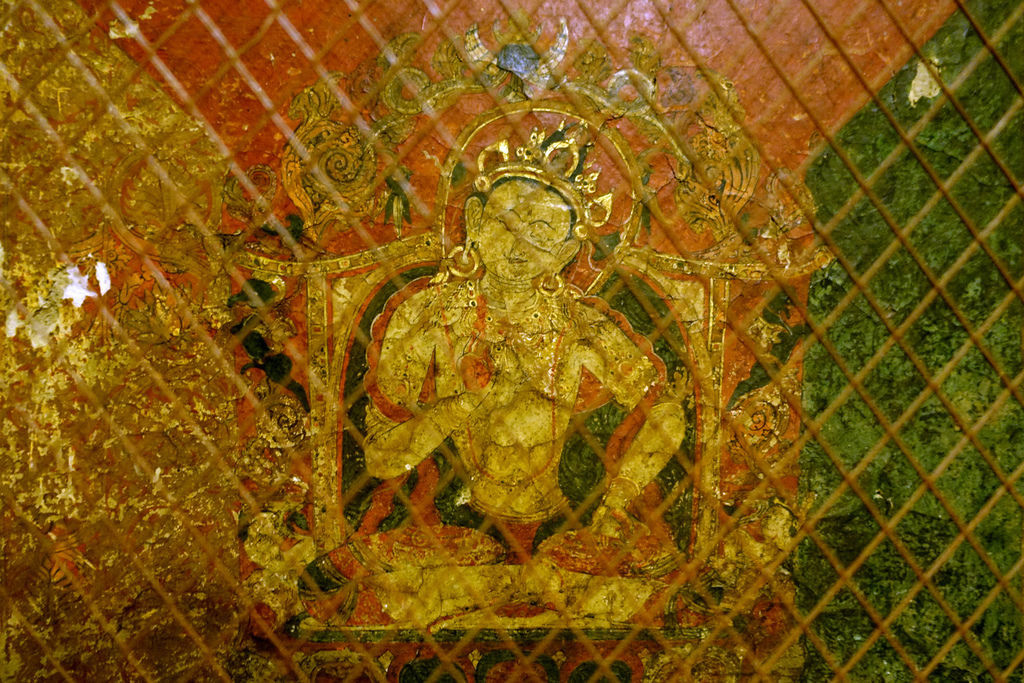
The murals in Xialu Temple were influenced by the inland art of the Yuan Dynasty and Buddhist art in Nepal, India and other places. Mainland art is reflected in the figures of the Four Heavenly Kings and the patterns of landscapes, pavilions and pavilions, the green dragon and red bird patterns in the Dharma Protector Temple, and the five Sakya Patriarchs (Gongga Nyingpo, Sonam Zimo, Drakpa Gyaltsen, The trees on the murals of Kunga Gyaltsen and Phagpa) are smudged and scratched, and the architectural styles on the murals of the corridors of the main hall. The Buddhist art of Nepal and India is mainly reflected in some compositions, character shapes, and traditional rituals of statues of Buddhas and Bodhisattvas. The dancing girls in the “Dancing Jataka” mural in the cloister of the main hall have obvious South Asian characteristics. The murals of Xialu Temple had a significant influence on the Tibetan murals of the late Yuan and early Ming dynasties. To the north, it influenced the murals of temples such as Juenang Temple, which contributed to the formation of the “Lado Art” style; to the southeast, it influenced the murals of Baiju Temple in Gyantse during the Ming Dynasty. The murals of Xialu Temple are of great significance as they connect the past and the future among the Tibetan murals of the Yuan Dynasty and Ming Dynasty. (online information)
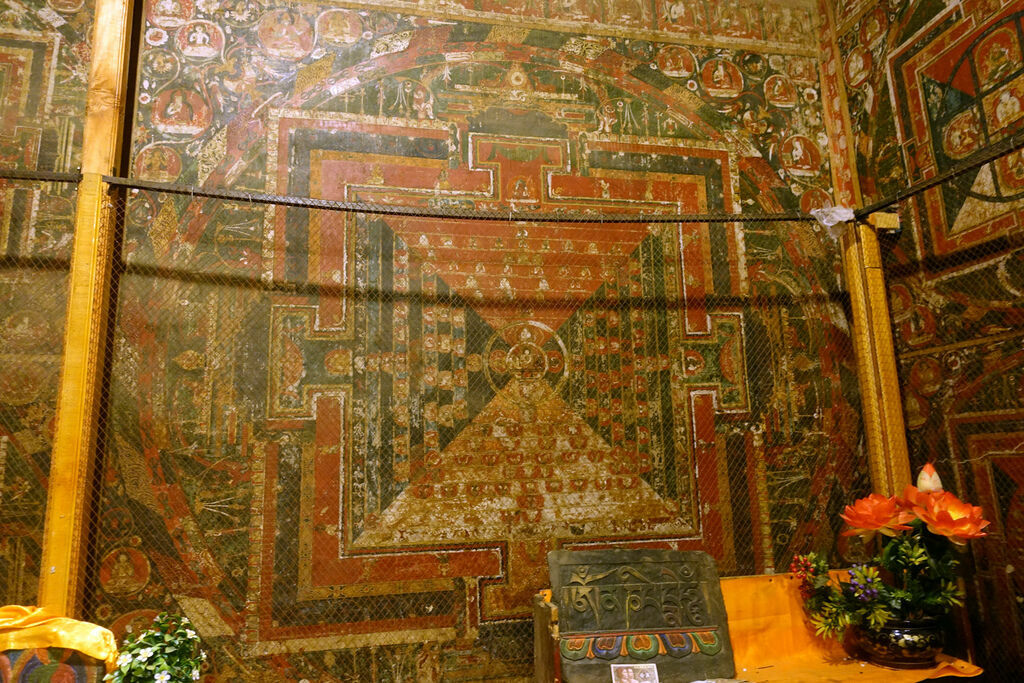
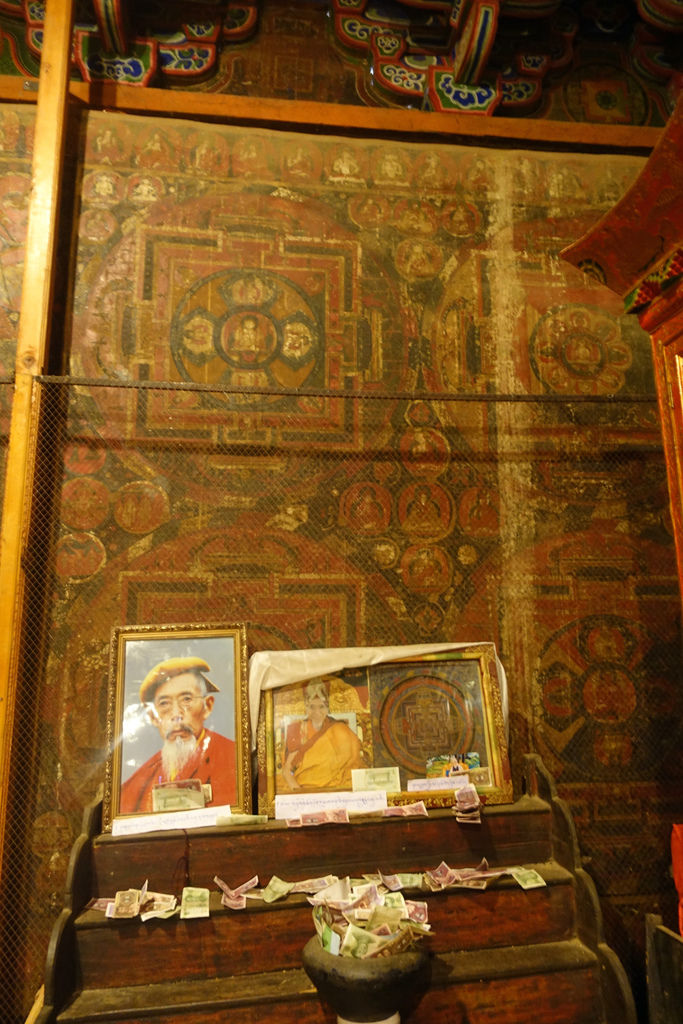
The walls of the entire temple are covered with murals, and each mural can tell many stories.
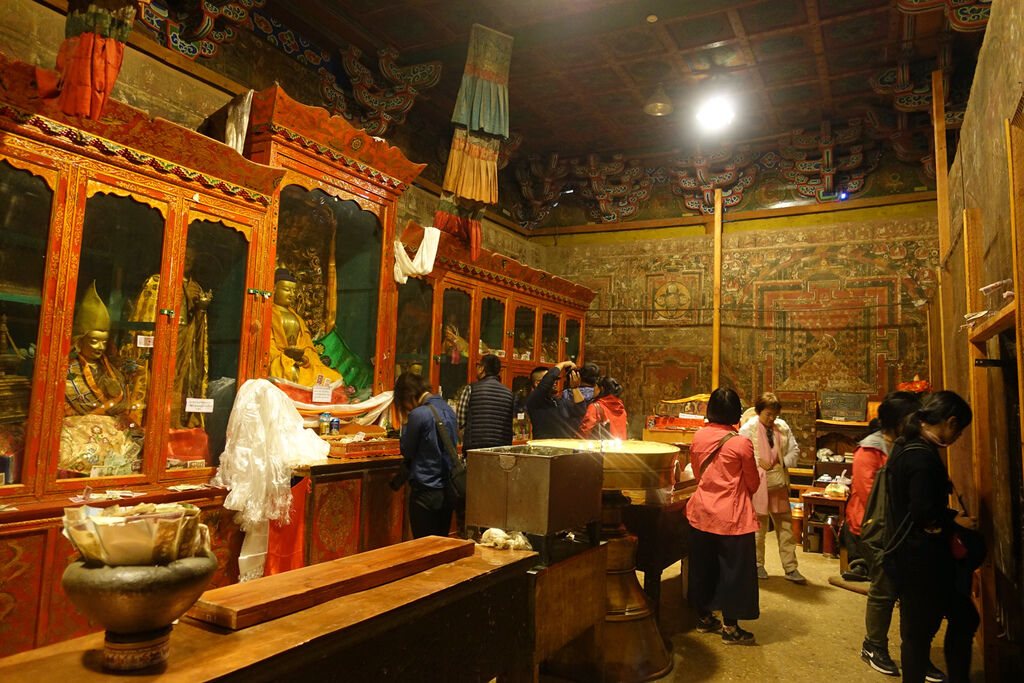
Visit the artistic treasures of Shalu Temple
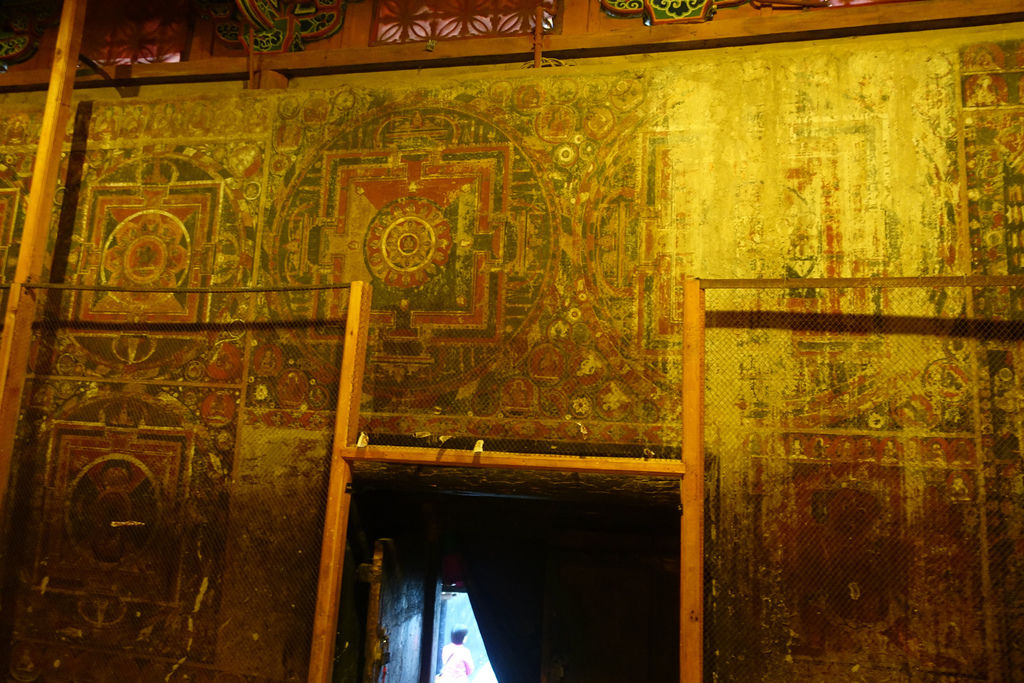
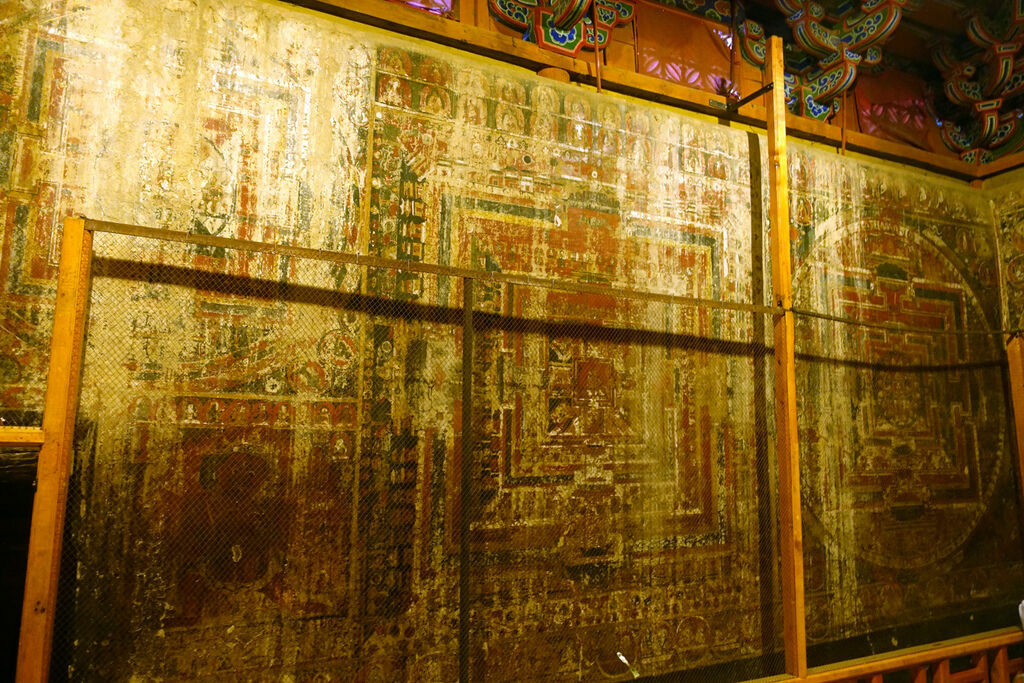
The temple in the middle of the chanting hall enshrines the statues of Sakyamuni and his eight disciples, and the two side halls on the left and right enshrine the statues of Infinite Light Buddha and Avalokitesvara of Compassion respectively. The halls on both sides prominently store the ancient woodcut versions of the Tripitaka “Kangyur” and “Tengyur” compiled by Master Butun, which are the treasures of the Shalu Temple. In addition to the statues of Sakyamuni and his sixteen Arhats, Tsongkhapa and his disciples, the most prominent thing on the second floor of the temple is the statue of Master Butun and his bronze pagoda. The statues of Tsongkhapa and his disciples were added after the Gelug sect became dominant. (online information)
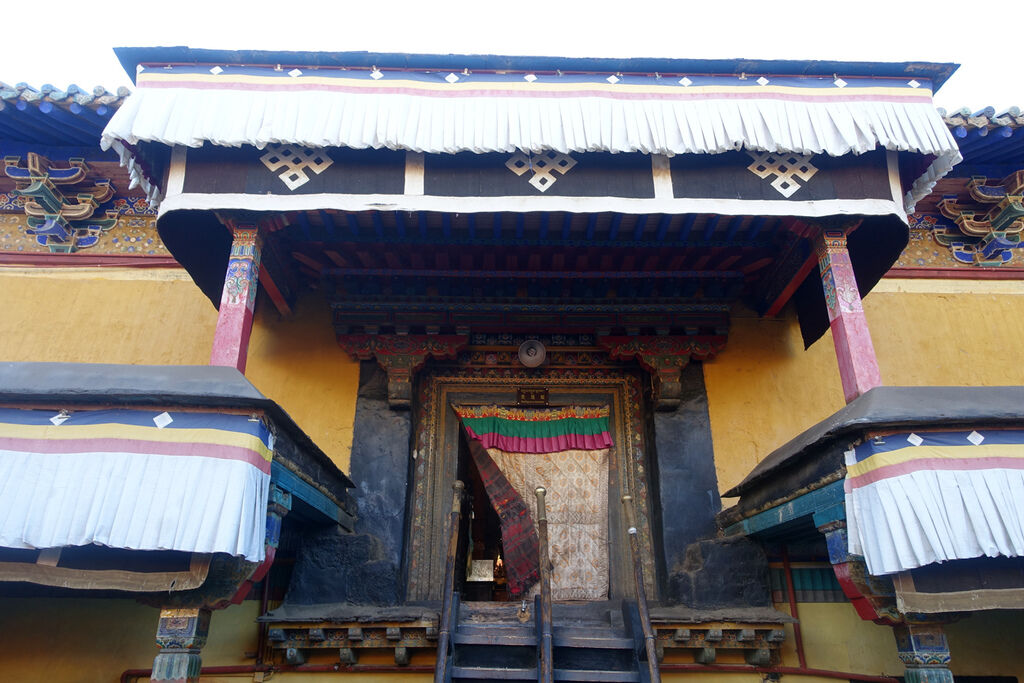
Butun Rinchen Drub (1290-1364) was the founder of the Shalu Sect of Tibetan Buddhism (also known as the “Butun Sect”). He was a scholar of the Sakya Sect and Chaopu Kagyu Sect of Tibetan Buddhism. His father, Shengzhuang Jixiangxian, and his mother, Fuyi, were both Tantric masters (Acharya). He studied scriptures from his mother since he was a child. At the age of 7, he went to the Chaopu Kagyu Sect to study Bodhicitta teachings. At the age of 8, he learned hexagrams, mantras, calendars, and calligraphy from other schools. He also studied the Dzogchen Dharma of the old sect with his grandfather for many years. , conducted an in-depth study of Dzogchen’s Universal Practice Tantra, the five parts of the first translation, the thirteen parts of the later translation, and the eighteen parts of the heart, mother and child. After receiving the novice ordination at the age of 18, he studied the exoteric teachings of the Small and Medium Prajna Sutras, Commentary on World Aspects, Vinaya, Yin Ming, etc. After receiving the bhikkhu ordination at the age of 23, he continued to study the sutra and esoteric teachings of various sects. From childhood to adulthood, he studied under 28 scholars, almost all of whom learned the sutra and esoteric teachings of Tibetan Buddhism at that time. Around the age of 30, he began to write, translate and compile the Tripitaka. After the reconstruction of Xialu Temple in 1320, when he served as the abbot of the temple, he widely spread the four tantras (the matter tantra, the action tantra, the yoga tantra, and the supreme yoga tantra), revised the Tripitaka, and compiled the catalog of the Tripitaka. His writings are 28 There are more than one hundred letters in total. In 1322, he wrote the “History of Butun Buddhism” (i.e., “The Origin of the Good Death Teaching”). Part of the book records the history of the spread of Buddhism in India and Nepal; the other part records the history of the spread of Buddhism in Tibet and Tibetan areas. It includes the history of Tibetan Buddhism in the post-proliferation period and the early period; the last part is the general catalog of the Tripitaka of “Kangyur” and “Tengyur”. Butun Rinchendrup integrated the characteristics of the Kadam sect, Kagyu sect, Sakya sect, Nyingma sect and other sects, selected the essence of sutra and esoteric studies, and focused on teaching his disciples. Monks from all over Tibet gathered in Xialu Monastery and made permanent disciples. There are more than 3,000 people, including famous disciples such as Faxiang, Tongfu, Baosheng and so on. (online information)
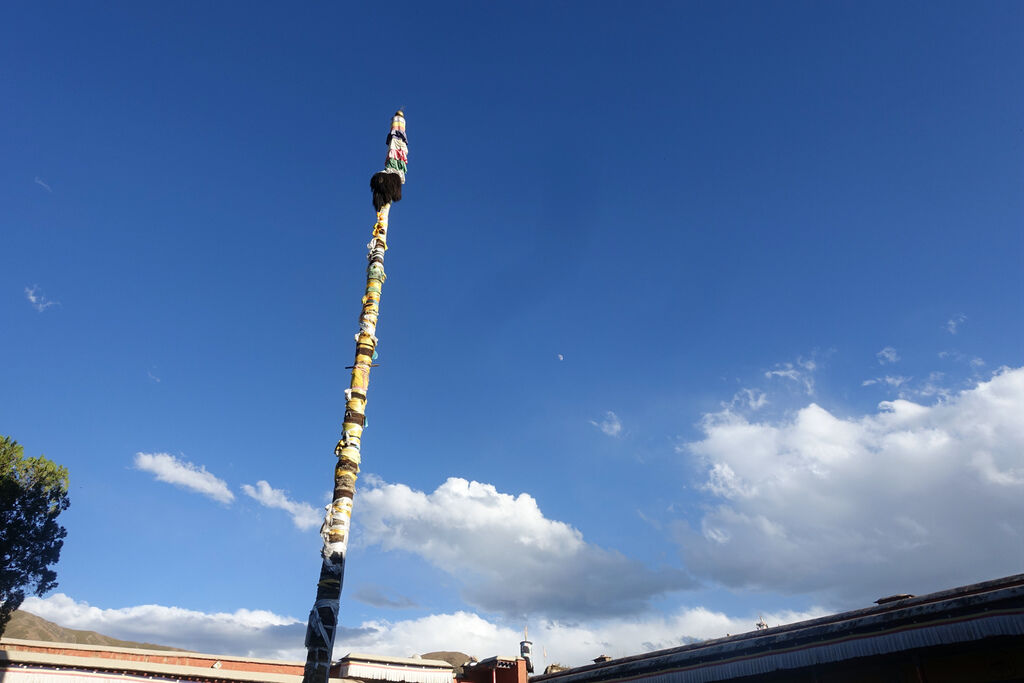
After the Yuan Dynasty unified Tibet, due to the greater power of Xialu Temple, the temple owner Jizai (a descendant of Jizun Xirabqiongnai) had a close relationship with Dzhungunchana, the younger brother of Sakya Dharma King Pasipa, so the emperor of the Yuan Dynasty granted Jizai the title of Thirteen thousand households in the Sakya Dynasty (Ladui Luo, Ladui Jiang, Gumo, Qumi, Xiang, and Xialu households in the back Tibet; Jama houses in the front Tibet) , Zhigong Wanhu, Caiba Wanhu, Tangboqi Wanhu, Pamozhu Wanhu, Yasang Wanhu; the head of Xialu Wanhu, one of the Yangzhuo Dhalong Wanhu at the junction of front and back Tibet). In 1329, Xialu Temple suffered devastating damage in the Shigatse earthquake. At that time, the temple master Ji Zai was in Beijing. When the emperor of the Yuan Dynasty learned that Xialu Temple was destroyed in the earthquake, he immediately ordered Ji Zai to return to Tibet to rebuild the temple and gave him a lot of money to fund the restoration. Ji Zai invited a large number of Han craftsmen from the mainland and transported glazed bricks and tiles (it is said that the glazed bricks and tiles were fired at Mozhu Gongka, Tibet under the guidance of Han craftsmen) and other materials. In 1333, the restoration work started with the joint efforts of Han and Tibetan craftsmen. This temple was built in a mixed Chinese and Tibetan style. (online information)
